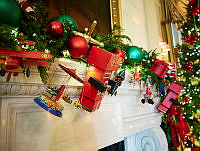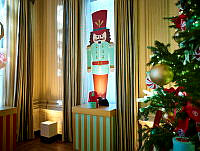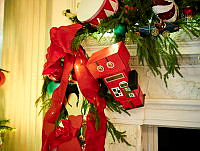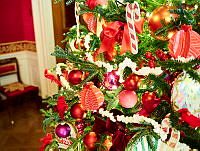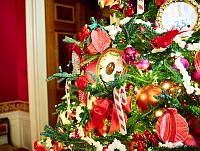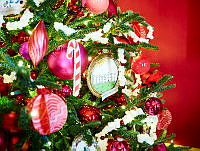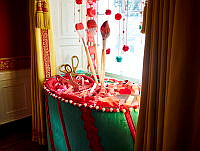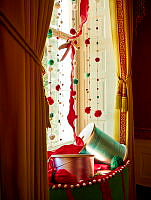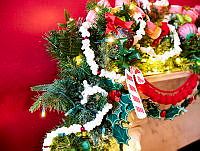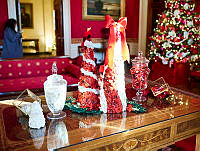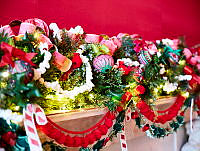Caroline Harrison

Caroline Scott was born in Oxford, Ohio, on October 1, 1832 to educator Mary Neal Scott and John Witherspoon Scott, a Presbyterian minister and president of Oxford Female Institute. Caroline, or “Carrie,” studied languages, music, and drawing at the institute, graduating in 1852.1 She also met Benjamin Harrison, a student at nearby Miami University, while in school. They later married on October 20, 1853.2
In 1854, the Harrisons moved to Indianapolis, Indiana, where Benjamin pursued a law career and Caroline raised their children, Russell and Mary. She gave birth to a third child in 1861 that passed away as a newborn.3 During the Civil War, Caroline supported the Union Army through philanthropy, serving on the Ladies’ Patriotic Association of Indianapolis.4 After the war, Caroline continued to be active in the Indianapolis community. She taught Sunday school at a local Presbyterian church and founded the Widows and Orphan’s Friends Society.5
Caroline also continued to nurture her love of art, painting watercolors and china from her personal home studio. She took lessons from artist Paul Putzki and exhibited her work locally.6 She also supported her husband’s political ambitions. During Benjamin’s tenure in the Senate, the Harrisons moved to Washington, D.C., where Caroline participated in social and political events.
In 1889, Benjamin Harrison became president and the Harrison family moved into the White House. Despite its elegant design and appearance, Caroline found a cramped, run-down home plagued by pests. To remedy these problems, she worked with architect Frederick D. Owen to design a new and improved version of the home, including additional office and living spaces, as well as a wing for an “American Art Gallery” and an enclosed garden.7 Although her plan never came to fruition, she improved many service spaces of the White House, including the kitchens. The Harrisons also installed electricity in the White House in 1891.8
Mrs. Harrison was keenly interested in the history of the White House and its interiors and furnishings. She expressed concern over the lack of historical objects from former administrations, inventorying the art and furniture and redecorating several rooms on the State Floor.9 When it came time to design the Harrison State Service, the first lady took on an active role in designing the china with her teacher, Paul Putzki.10 She continued her art classes as well, inviting cabinet and congressional wives to learn with her at the White House, and her own artwork graced the walls of the White House. The Conservatory provided floral inspiration for new pieces.11
As first lady, Caroline Harrison continued to support philanthropical efforts and lent her support to various women’s causes. In 1890, she became the first president general of the National Society Daughters of the American Revolution (NSDAR). She also raised funds for Johns Hopkins University medical school on the condition that it allow women to enroll.12
While at the White House, Caroline fell ill with tuberculosis and her condition worsened throughout the spring and summer of 1892. She spent several months recovering in the Adirondack Mountains of New York that summer but lost her battle with the disease on October 25, 1892. Funeral services were held in the East Room of the White House, and Caroline Harrison was buried at Crown Hill Cemetery in Indianapolis, Indiana.13
Footnotes & Resources
- See Diploma, https://library.whitehousehist....
- “Caroline Scott Harrison,” Benjamin Harrison Presidential Site, https://bhpsite.org/learn/the-....
- Ibid.
- “Address of the Ladies’ Patriotic Association of Indianapolis to the Women of Indiana,” Indiana State Sentinel, October 23, 1861; “Indiana State and Sanitary Fairs,” The Indianapolis Star, September 17, 1864.
- See Katherine E. Badertscher, “Organized Charity and the Civic Ideal in Indianapolis: 1879-1922,” Dissertation, Indiana University (2015); “Mrs. Benjamin Harrison,” The Indianapolis Journal, November 12, 1888.
- “Mrs. Harrison Paints,” The Sun, November 25, 1888; “The Fancy Work Exhibitions,” Indianapolis News, January 11, 1887.
- See William Bushong, “Unbuilt White Houses of the 19th Century,” White House Historical Association, https://www.whitehousehistory.....
- Irwin Hoover, Forty-Two Years at the White House (Houghton Mifflin, 1934), 7.
- “Mrs. Harrison’s Inventory,” Evening Star, January 18, 1890.
- William Allman, Office White House China: From the 18th to the 21st Centuries (Washington, D.C.: White House Historical Association, 2016), 129-130.
- “Mrs. President Harrison’s Art Works,” The St. Joseph Herald, January 18, 1891,
- “Caroline Scott Harrison,” Benjamin Harrison Presidential Site, https://bhpsite.org/learn/the-....
- “Seeking the Adirondacks,” The Philadelphia Times, July 19, 1892; “The Wife of Our President Is No More,” The Chattanooga Daily Times, October 25, 1892.



















































